One of the best things about repotting season is that it provides an opportunity for us to select new containers for our trees.
When we move trees from training pots or poorly matched containers to something better, it can be like having a new tree in the yard.
One tree that stumped me this year was a cork oak. The tree is new to the garden and has yet to be worked on, but I wanted to find a container that suited the tree and would provide some space for development. (I often use oversized containers for trees that are a few years away from having their final silhouette.)
Here are some obvious and not-obvious options for the cork oak along with comments about what I do or don’t like about the combination.
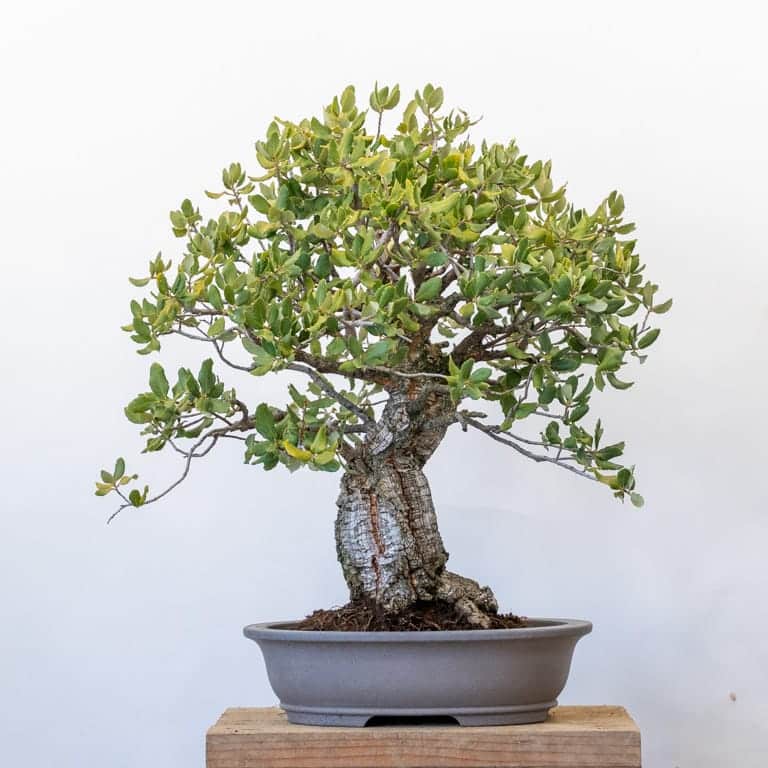
Pot 1 – gray oval (unglazed) with curved sides
Over the years I’ve used more gray pots for oaks than brown pots, and more ovals than rectangles. Gray clays call attention to the primarily gray bark and provide contrast to the brown stripes at the base of each fissure along the trunk.
The soft silhouettes of cork oaks lend themselves well to ovals, but not to ovals with large lips.
The above pot has a small lip and two curves along the pot wall, one outward and one inward. I think that shape makes more sense with trees that have more curves along the trunk.
This pot is also on the small side for a tree that will require several years of development before having primary branches large enough to complement the corky trunk.
The second pot I tried is also a gray oval, but the sides have a single curve outward and the size is a better fit for the tree.
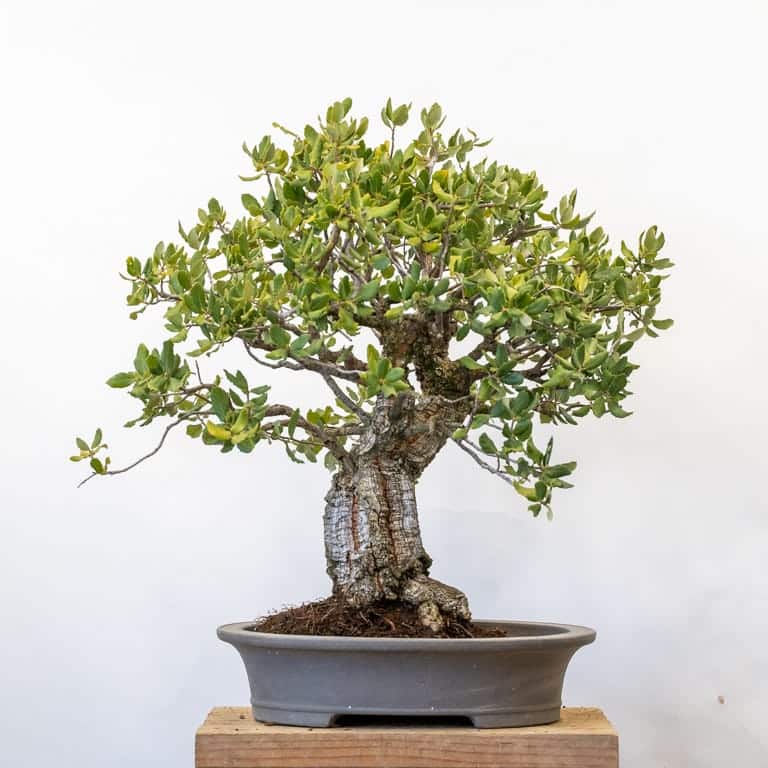
Pot 2 – gray oval (unglazed) that flares outward
This isn’t my favorite shape pot for cork oaks, but it’s not far off and the size is right for the time being.
The next pot I tried doesn’t have a lip, but the sides are vertical which I don’t think suits the tree very well.
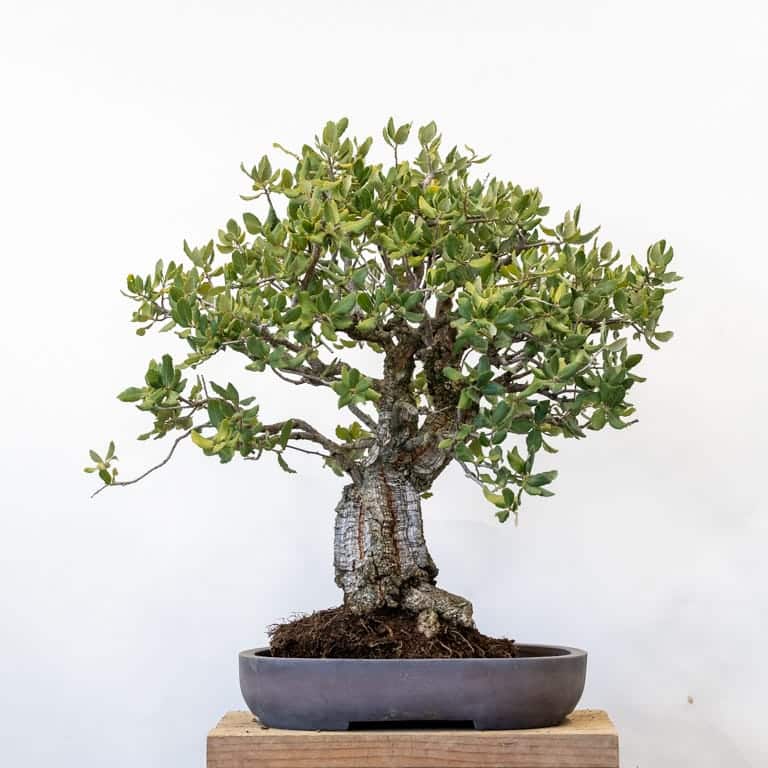
Pot 3 – reddish/brown oval (unglazed) with no lip
I’m also not a fan of the color, and the container is way too shallow for this stage of development.
Next up is a dark gray rectangle.
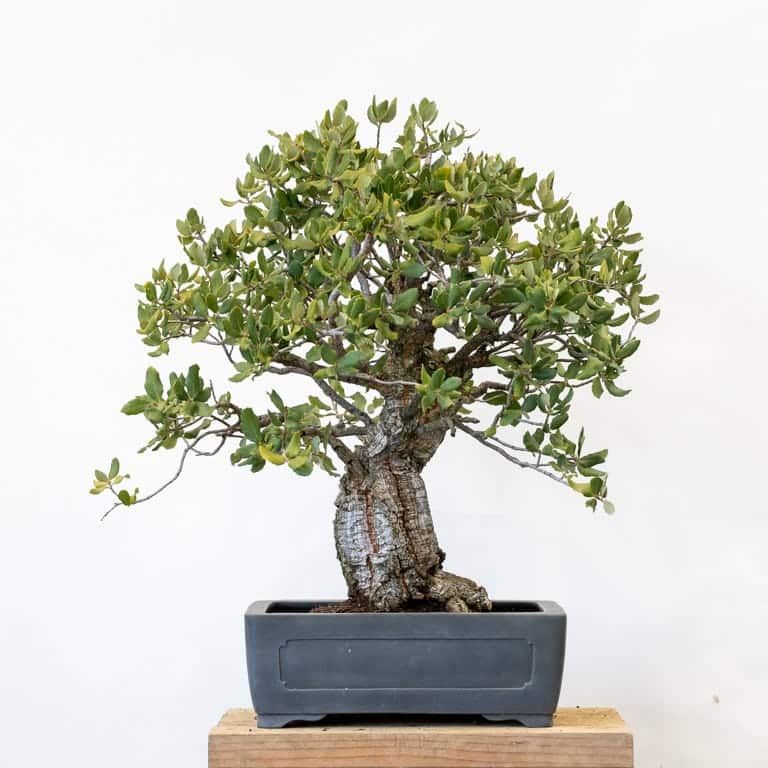
Pot 4 – gray rectangle (unglazed) with window
Rectangles strike me as too strong for oaks that don’t have massive trunks or angular features. The depth of the above rectangle makes the trunk look small.
I think the brown rectangle below is a better match for the tree, but it’s not great and it’s too large for the tree.
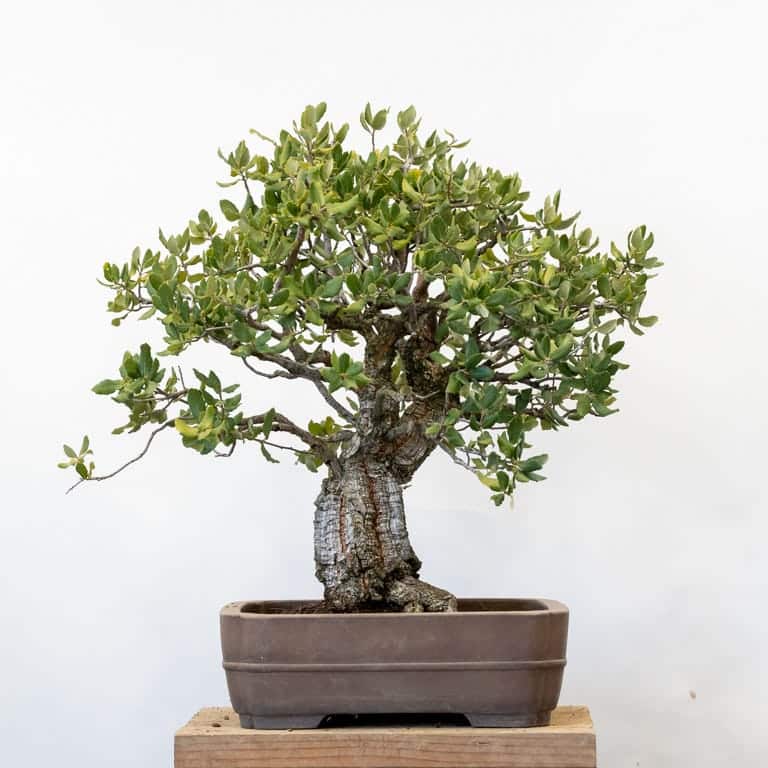
Pot 5 – brown rectangle (unglazed) with band and pinched corners
As you can see in the photo below, even greater depth and cloud feet aren’t a good complement for the tree. Something similar might be appropriate when the tree is closer to its final silhouette, but the more ornate details would only make sense to me if the tree had strikingly refined features like a perfect silhouette, great surface roots, and clearly defined pads – all features that we don’t typically associate with cork oaks.
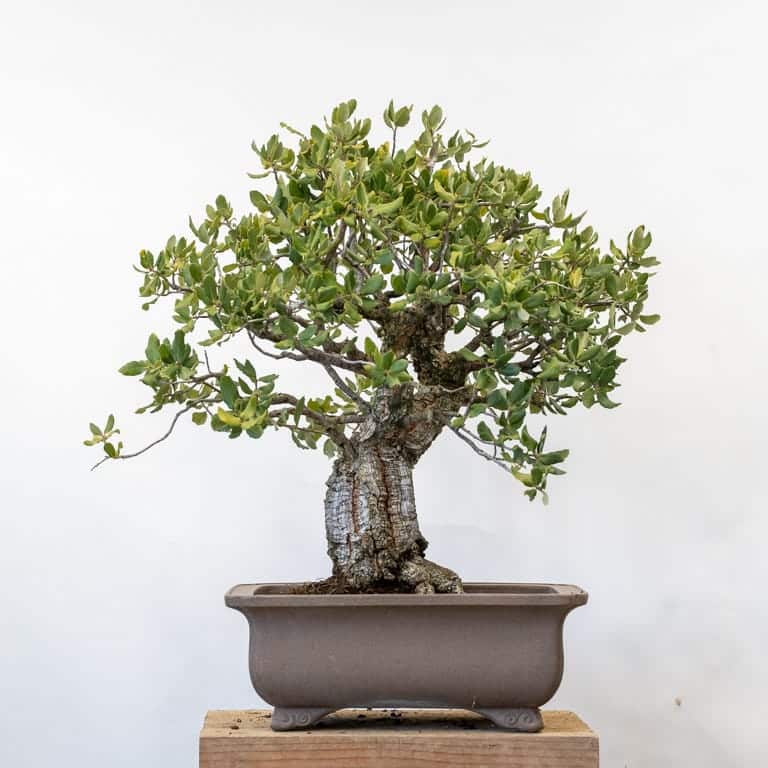
Pot 6 – deep brown rectangle (unglazed) with pronounced lip and cloud feet
The above containers are all made in Japan. To try a pot with less refined features, I tried a few domestic containers made by Sara Rayner. The first was an unglazed oval.
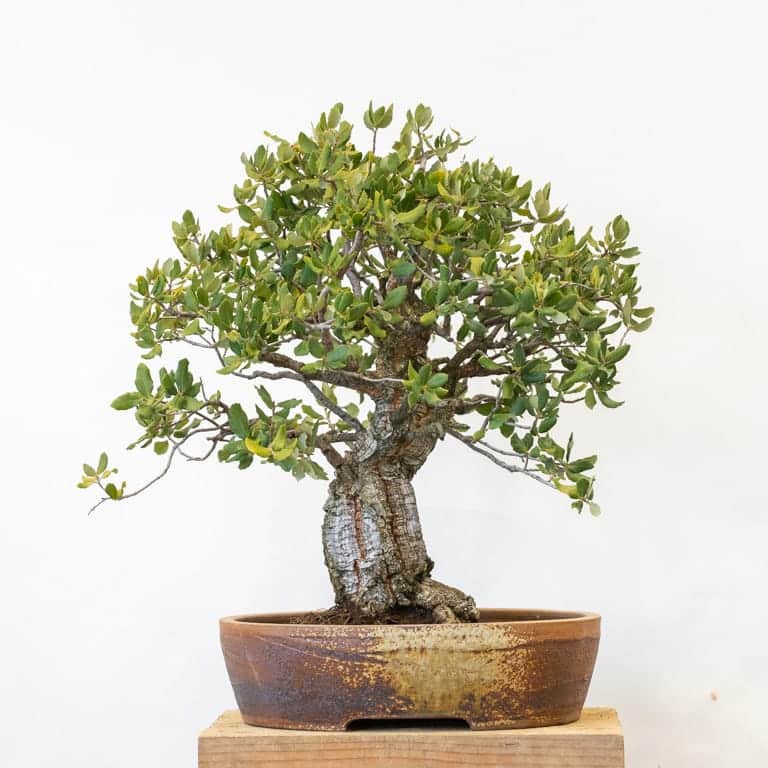
Pot 7 – informal brown oval (unglazed) by Sara Rayner
Although this shade of brown isn’t my favorite match for the oak, it’s not far off and I like the general shape as the sides slightly flare outward. It’s too big, however, and a bit much for this stage of development.
Not forgetting that broadleaf evergreens can look good in glazed pots, I tried a deep rectangle with rounded sides.
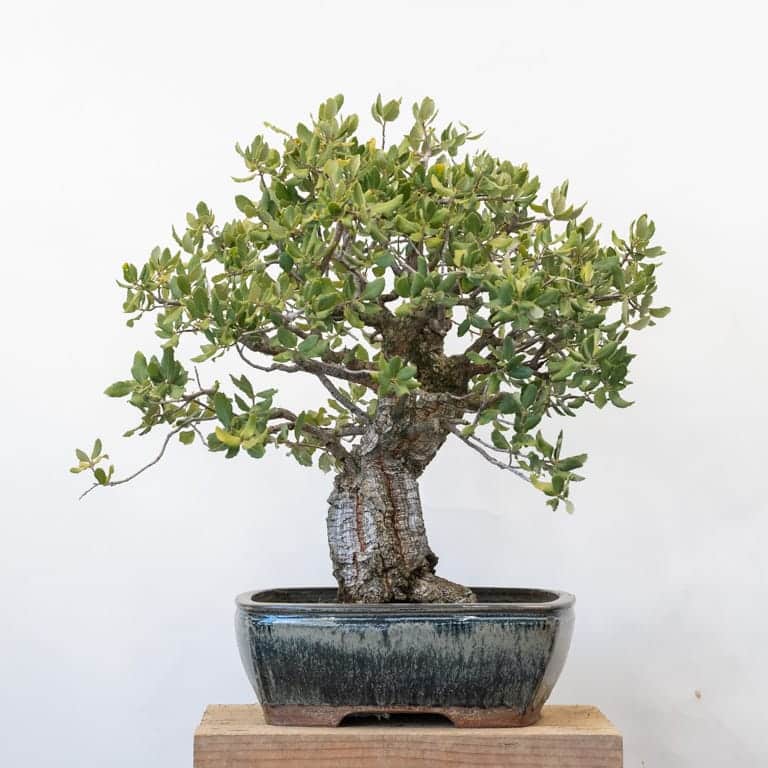
Pot 8 – blue rounded rectangle by Sara Rayner
I really like the combination here. Were the pot not huge for the tree I’d likely use it as a growing container. I’ll keep this pot in mind if I come across a larger oak as I think the color and shape suit the tree well.
Finally, I tried a prettier version of the above pot but found it to be too pretty (and too large) for the oak.
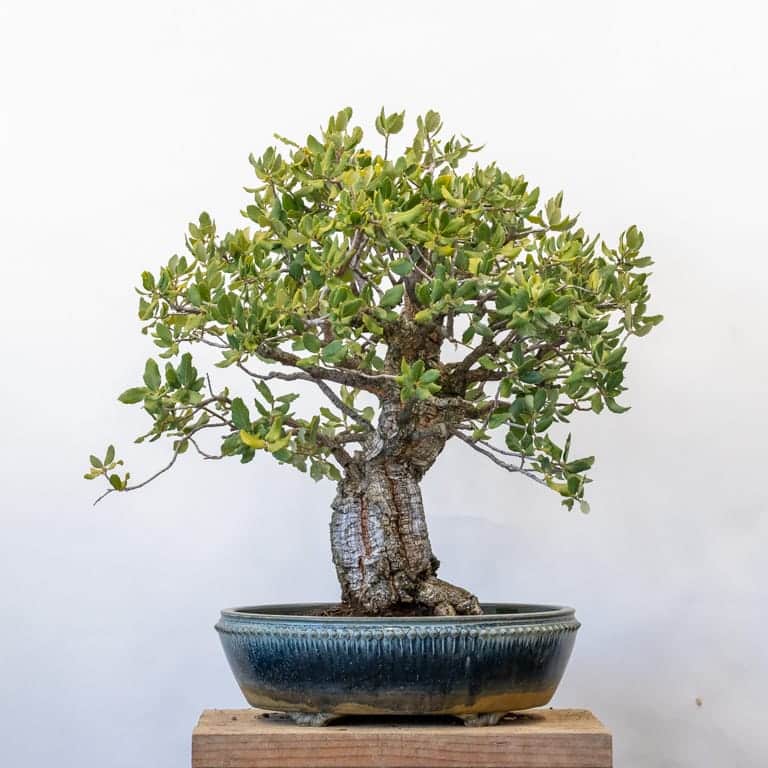
Pot 9 – blue oval with bullets by Sara Rayner
It turns out I didn’t have the “perfect” container for the tree, but perfect is relative at this stage as the tree would do fine in most of the above pots as it’ll take five or more years before the tree has a refined silhouette.
I went with the second gray oval as I like the color and size for the tree even though it’s not the exact shape I’d like to use in the future.
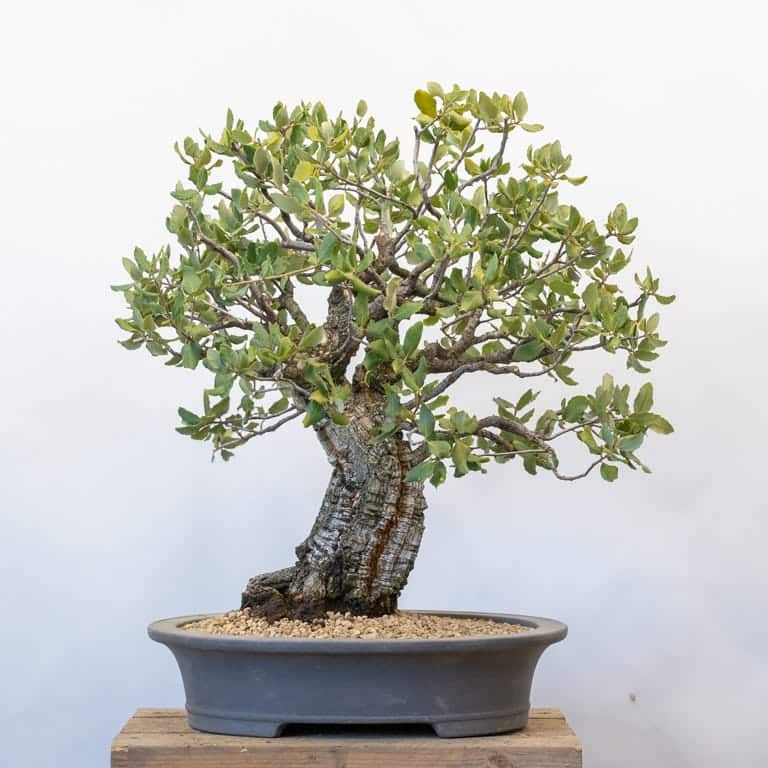
After repotting (pot #2), 22″ tall
You may notice that I went with the other side of the tree as the front – further evidence that the tree has a ways to go!
Do you have a favorite container among the options above – or a completely different style that you think complements cork oaks well? Let us know in the comments below.
Subscribe to Bonsai Tonight
New Posts Delivered Every Tuesday and Friday
Greg Wade says
I really like Pot #8 by Sara Rayner. Perfect color, glaze and shape, and you wanted a pot on the large size. It seems like if the tree were to be raised in the pot by an inch, you’d see more of the nebari and the proportions of tree to pot might work better. Thoughts?
Jonas Dupuich says
That’s right, setting the tree at the proper height would make #8 a better fit. We tried this and it still looked big (plus I might have another use for the pot).
Michael says
I am curious about the actual volume of pot 8 (which you describe as “huge”) and pot 9 (also clearly too large) compared to that of pot 2 and why these were too large for a tree still several years in development.
Jonas Dupuich says
Hi Michael – pot 8 is close to square which means there is a lot of space front-to-back as well as side-to-side. Plus it was one of the deeper pots I tried. Although it looks relatively good from the front, in person it looks bigger when you consider the front-to-back space.
Ronald Smith says
I probably like #8 the best, but tree would look better if potted shallower in pot.
mike says
por 8 works for me very well.
MrFancyPlants says
Thank you for taking us along in the process; it is quite informative.
I have a general question, about pot selection, or rather plant section for a pot, to climb the tree feet first.. A friend gave me a large green glazed rectangular with soft corners. What the heck am I going to put in it.
Maybe a massive, white blooming, azalea?
Jonas Dupuich says
Green pots can be fun. They’re a good choice for some deciduous trees or any broadleaf evergreens. The trick is finding a foliage color that doesn’t look too similar to the green of the pot.
The other consideration is when you want to show the tree. For azaleas, green can be a great option to show off the flowers.
Flipping through show books or images online in search of how others use green pots might help suggest specific uses for the pot.
BVF says
Nice tree. Pot #1 was my pick, similar effect as 2 but smaller size makes the tree appear more massive. If it’s still in development, pot 2 makes more sense.
Tyler Peterson says
Great post, Dan I suggest you tag these types of articles with the tree type so that it can be referenced that way later?
Jonas Dupuich says
Thanks, Tyler! I typically tag posts by species and topic so I can at least refer to other articles dealing with the species. I’d love to tag the individual trees but haven’t gotten that far yet.
Here, for example, is a link to other cork oak posts: https://bonsaitonight.com/tag/cork-oak/
Mike Barbieri says
My favorites are #2 or a shallower version of #8.
Great post! This is an awesome exercise, especially for folks who do not have a deep pot collection.